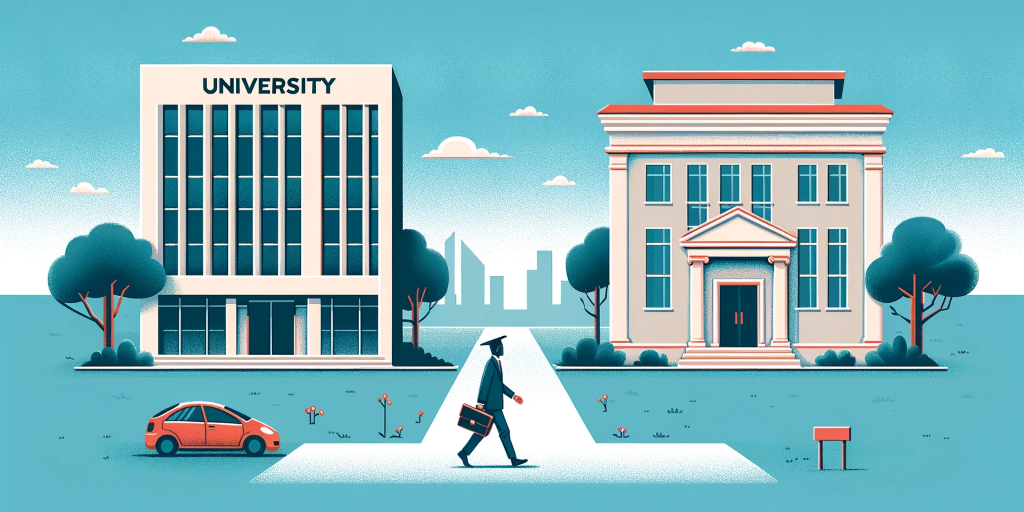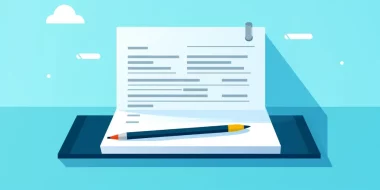“How to make a resume for first job,” you ask?
In this highly competitive job market, even the most experienced professionals can struggle for success. So how can you, a fresh graduate with no experience, stand out from the rest? Believe us, you can.
We'll show you how to highlight your skills and academic achievements, and other relevant experiences you might have, in a way that makes up for the lack of experience and catches an employer's eye.
In this article you'll find how to make an effective resume with no experience and land your first job. You'll also find out:
- If you need a resume for your first job;
- How to make a resume for first job in 6 steps;
- How to know what is relevant;
- First job resume examples.
But let's start with the basics...
What even is a resume?
In short, resume is a document which presents your career history in a succinct way. It provides an overview of your most relevant achievements (professional and educational):
- the skills you've acquired;
- any qualifications, awards, or certificates you've gained;
- your education;
- and work experience.
Stylistically speaking, resumes are formal, brief, and packed with information.
The aim of a resume is to present a summary of everything you need to convince the hiring managers that you are the right person to fill the open position in their company.
Who is the resume meant for?
The target audience of your resume are the recruiters or the hiring manager.
Resume serves as the initial point of contact between you and the people who decide whether you get invited to a job interview. With a good resume, you can make a strong first impression which will get you on the list of promising candidates.
Recruiters like brevity and efficiency, so make sure you communicate with them in clear and concise language.
What does a resume consist of?
Given the volume of information included in a resume, you must organize it into appropriate and clearly distinguished resume sections. This will prevent your resume from looking cluttered and chaotic.
Generally speaking, there are two types of resume sections: necessary and optional.
The necessary resume sections include:
From the optional sections, the most frequent include:
- Hobbies and interests
- Awards and achievements
- Certificates
- Volunteering
- References (though this one is mainly used in CVs, rather than resumes.)
How long should a resume be?
Choosing the right resume length can be tricky, believe it or not. Luckily for you, there is only one correct answer.
Our recommendation to keep your resume to only one page probably won't surprise you.
Do you need a resume for your first job?
Absolutely.
Whether it's your first or fiftieth time, you always need to attach a resume to your job application.
Your resume is something like an ID card in the workforce – it tells people who you are, what you can do, and how they can reach you. Without a resume you won't get invited to a job interview; and without a job interview, well, you won't get a job.
Maybe you feel that since you have no practical experience, writing a resume is pointless - this statement couldn't be further from true.
After all, you would have to create a resume at one point in your life, so it may as well be now.
The simple fact of having a well-done resume already displays a certain level of professionalism and readiness for the workplace.
Knowing how to best present yourself and your abilities – especially when you have no previous experience to vouch for them – is a skill in itself. And every skill needs practice.
So let's practise!
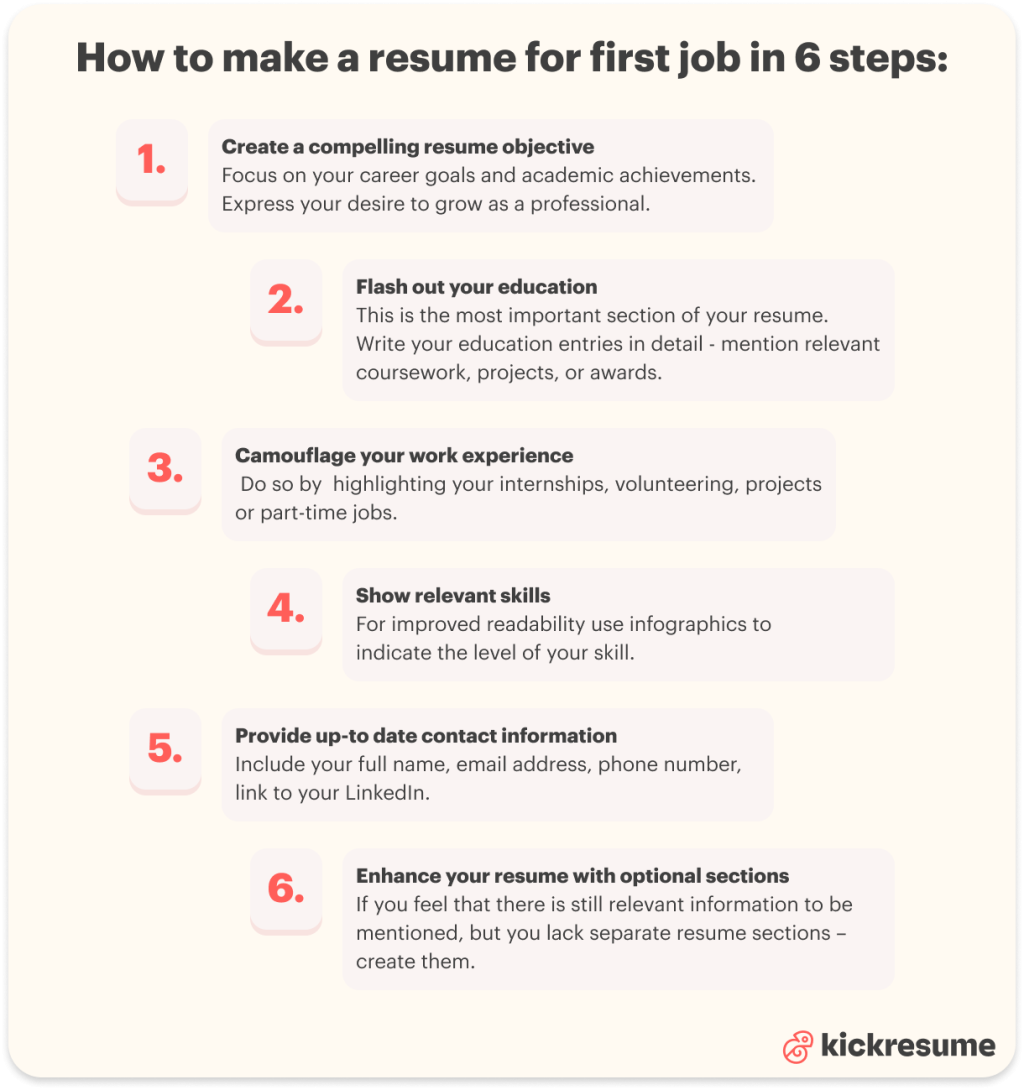
How to make a resume for your first job in 6 steps
Writing a good resume for your first job can be intimidating; but following these 6 steps will make the process much easier.
- Create a compelling resume objective.
Instead of a resume summary, opt for a resume objective. In 3-5 sentences, focus on your career goals and academic achievements. Express your enthusiasm for the job, your goals, and your desire to grow professionally.
- Flash out your education.
This might be the most important section of your resume. Write your education entries in detail. You can mention relevant coursework, projects, or awards.
- Camouflage your work experience.
If you lack professional experience, you can build on your relevant internships, volunteering, independent projects, your teen jobs, summer jobs, or part-time jobs. Especially highlight those that are at least somewhat relevant for the job.
- Show relevant skills.
Highlight hard skills, like languages, computer skills, or other tools. Also, don't forget to include soft skills, which are personality traits and are transferrable from your old jobs or school. You can also organize your skills section into smaller categories and use infographics.
- Provide up-to-date contact information.
Include your contact information in your resume header. Make sure they are clearly visible and easy to find with the first glance. Don't forget to include your LinkedIn profile.
- Enhance your resume with optional sections
If you feel that there's still relevant information to be mentioned, but you lack separate resume sections – create them. For instance, create a separate 'Independent Projects' section and boast about your endeavours.
Now, let's go through these steps in detail.
Step 1: Create a compelling resume summary/objective
What is the purpose?
What separates a good resume from a great one is its ability to immediately capture the attention of whoever is reading it. A nifty piece of text called a resume summary does the trick.
This brief text placed near the top of your resume, close to your contact information, condenses your resume highlights into 3-5 sentences.
It provides an overview of your most impressive professional qualities:
- Most significant achievements
- Most relevant skills
- Experiences that cater to specific needs of the job you want
What can you do?
Obviously, you can't really do all that. But you can still create a persuasive short text that will make the recruiters keep on reading the rest of your resume.
Instead of writing a resume summary, try to compose a resume objective.
Instead of past experience and achievements, you can highlight your:
- Career goals
- Motivation
- Enthusiasm to learn and grow professionally
- Educational achievements
Look at this example:
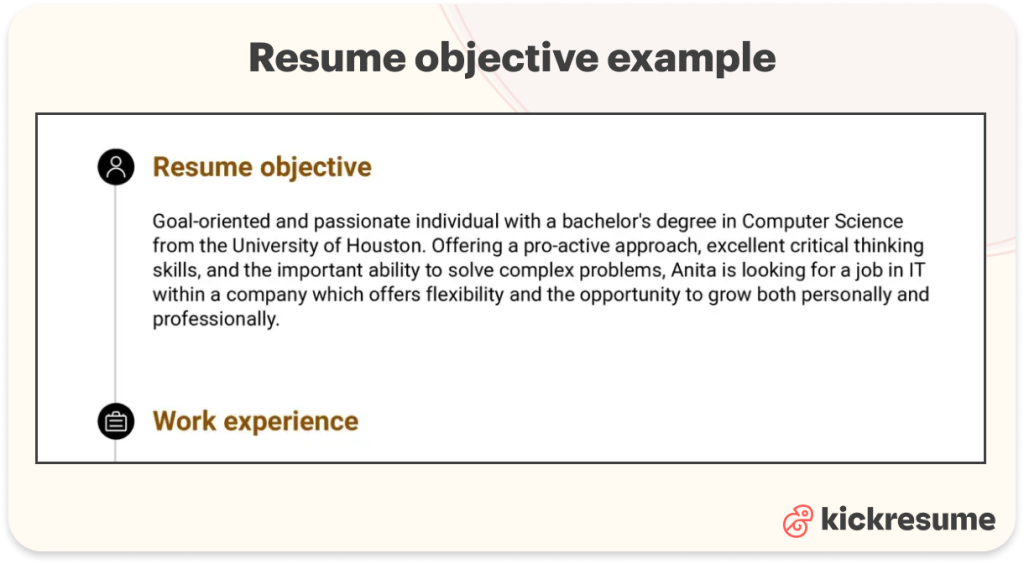
What makes this resume objective good?
- Anita shows the recruiters her qualifications by informing them of her bachelor's degree.
- She states exactly what she can offer to her future employer: proactive approach, problem-solving, critical thinking.
- She expresses her desire to “grow professionally”
Step 2: Flash out your education
What is the purpose?
The education section is where you list your degrees and your academic accomplishments. To be honest, candidates with years of professional experience need this section only as a way to show that they hold an academic degree. Simply because such is the convention.
In their case, an education entry contains the following:
- The name of the institution
- Location of the school
- Years of study
- Level of study
- Name of their degree
What can you do?
For fresh graduates, the education section of a resume is often the most significant part. Make sure to put some meat on the bones … a lot of it actually.
At this point in your professional life, your academic achievements are probably the only way to showcase your most relevant abilities and substantial qualifications. Throughout your academic journey, you've likely gained and achieved a multitude of things, use this section to show your range.
Apart from the information shown above, you should elaborate on your education entries by detailing your:
- Relevant coursework. Being fresh out of school does have a certain advantage – all the theoretical knowledge is still in your head.
- Final thesis. Your final thesis is the climax of your studies. It's by far your most elaborate project. It requires a lot of effort, good time management, dedication and long-term commitment – all the qualities highly desired by employers. Not to mention if the subject of your thesis directly links to the job you're applying for!
- Extracurricular activities. It's good to demonstrate your interest in things outside of the prescribed curriculum – this might suggest similar tendencies in work environment.
- Projects you've worked on. Apart from the knowledge, you've gained valuable teamwork experience.
- Scholarships.
- Academic awards. Make the recruiters recognize your hard work.
- GPA. Include it only if it's higher than 3.5.
In short, make note of every relevant information that will make your future employers see your potential.
Keep in mind that your education entries should be listed in reverse-chronological order.
Consider this example:
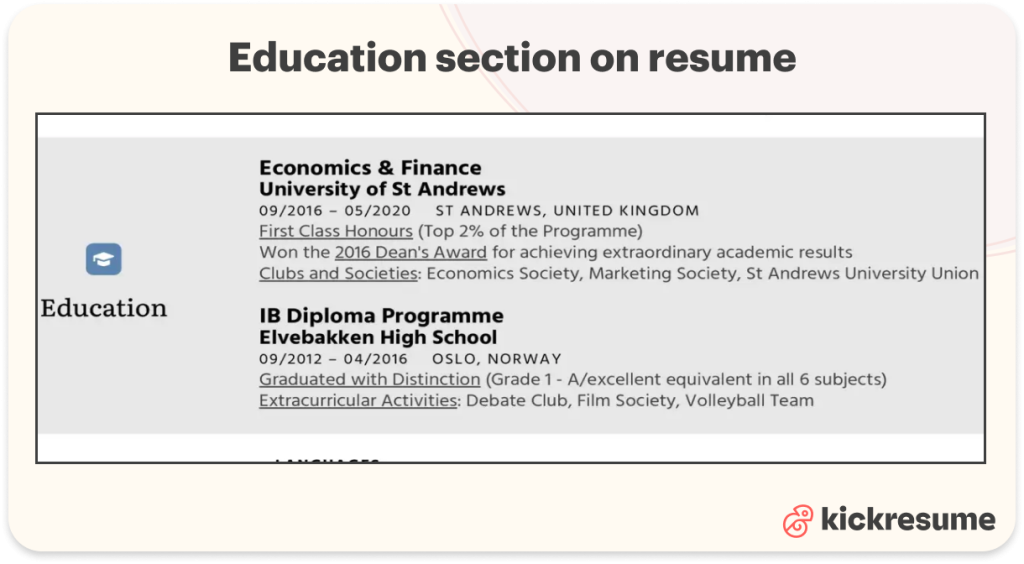
What makes this education section good?
- By mentioning the acknowledgements for her academic performance, Hannah shows the recruiters that she is focused, hard-working and consistent.
- Her membership in various societies and clubs suggest that she's developed strong communication and networking skills.
Step 3: Camouflage your work experience.
What is the purpose?
Normally, the work experience section takes up the most space on a resume. It is here where candidates demonstrate their acquired skills and know-how with practical examples from real-life professional situations.
What can you do?
One of the defining characteristics of those just entering the workforce, such as yourself, is the lack of practical work experience.
This doesn't have to mean that you have no experience whatsoever.
Instead of dealing with this section in the traditional way, you can make for your lack of experience by focusing on:
- Internships. You can treat your internships as if they were regular jobs. In a few bullet points, note your responsibilities and accomplishments. Include any projects or studies you've participated in. What problems did you solve? What outcomes did you contribute to?
- Independent projects. Feel free to add any kind of projects you've worked on. These can be academic, personal, work-related, freelance projects, etc. For instance, if you created a website for your college society, include this along with the transferrable skills you gained and a URL link.
- Volunteering. Volunteering is as valid as any other work experience. Just because something wasn't paid, doesn't mean that it didn't bring you anything valuable. Plus, if the company you're interested in shares your passion for volunteering, this can be your greatest weapon.
- Part-time jobs. What relevant tasks did you undertake? What were your responsibilities?
If you pick one, two, or combination of all – keep in mind that all the information on your resume should be relevant! This means that everything you decide to put on this document has to connect to the job you're applying for in some way.
If none of your experience aligns with the demands of your target job, you can still include it. Just make sure to focus on all the transferable skills you’ve gained because of it.
Here is one example of how to deal with the feared “work experience” section:
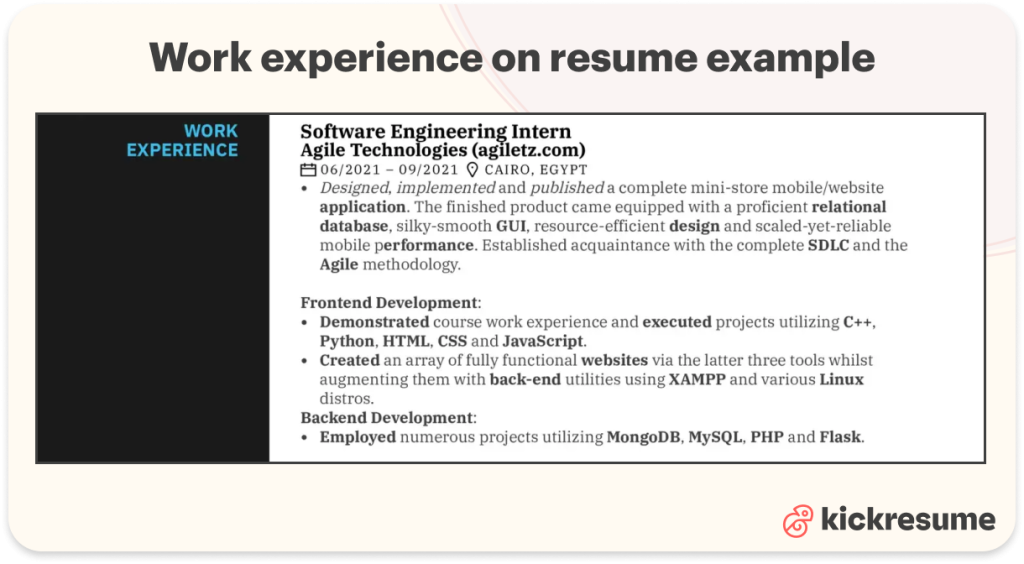
What makes this work experience section good?
- Despite not having any full-time experience, Nathan utilized his internship to the maximum.
- He clearly states the competences and tasks he undertook.
- He details the accomplishments and skills he employed with specific examples.
- To make the text more readable and organized, he used bullet points and bold fonts. As a consequence, the whole entry feels less dense.
Step 4: Show relevant skills
What is the purpose?
It's quite straightforward, really – the skills section on your resume is there to highlight any skills that can help you get the job.
Your abilities fall under one of two categories: hard or soft skills.
Hard skills are those you can obtain through education or training – they can be easily measured and quantified. The most prominent hard skills are:
- Foreign language proficiency
- Computer skills (coding languages, spreadsheets, etc.)
- Completed training (forklift operation, driving licence, etc.)
Soft skills, on the other hand, aren't so easily defined. We can say that these are the interpersonal and social nuances one cultivates throughout years and years of experience. You can also know them under the term transferable. Some of the most sought-after soft skills include:
- Communication skills
- Problem-solving skills
- Leadership
- Teamwork
- Reliability
- Time management
Since soft skills aren't strictly tied to a particular job position, you can apply them across all industries. Yes, even you.
What can you do?
Although both hard and soft skills can be included in the skills section, we recommend you to do this:
- Use the skills section to mark your hard skills. Since these can be objectively measured, you can mark down the level of your proficiency by using infographics. Your resume will be sleeker and visually more interesting. Add tools and software that you already have experience using and are relevant to the position you’re applying for. For example, a VoIP phone system, CRM platform, or call center software will be a huge plus for customer support roles, and keyword research and SEO tools will bring benefits if you’re applying for an SEO-related role.
- Sprinkle your soft skills throughout other parts of your resume. Don't just write communication skills and blackout three out of five circles – that doesn't say much. We aren't saying that this is necessarily wrong; but you can do better!
- Instead of just writing teamwork, mention your participation in various projects when you talk about your education.
- Don't just write reliable, show how many responsibilities and competences you were able to handle during your internship.
- Instead of just writing leadership skills, mention the fact you led multiple group projects in your resume objective.
Let's look at Anita's resume again. Focus on her skills section:

What makes this skills section good?
- She included hard skills only, which allowed her to include more of them. (all relevant to the job position though!)
- Anita organized her skills section into two categories. This made it more readable.
- By including infographics, she elevated the overall look of her resume.
Step 5: Provide up-to date contact information
What is the purpose?
A good resume is incomplete without your personal contact information. The recruiters need to know how to get in touch with you as soon as they look at your resume. Don't forget to clearly state your:
- Full name;
- email address;
- phone number;
- and links to your LinkedIn, online portfolio of social media account (only if relevant!)
What can you do?
Make your contact info stand apart from the rest of the text. Place it in the topmost part of your resume (also called the resume header).
You can use a bigger font size to draw immediate attention to your name.
And for the love of God, don't use unprofessional-sounding emails such as prettyboy@yahoo.com.
Step 6: Enhance your resume with optional sections
What is the purpose?
Optional sections in a resume are those that are not essential but can be included to provide additional context about your skills, experiences, or personal interests.
These sections can be particularly useful for highlighting aspects of your profile that might not be evident from the standard sections.
What can you do?
When it comes to organizing your resume sections, there really is only one rule. The more important the information, the sooner it should be accessible.
If you want to draw the recruiters' attention to all the certificates you've gained – create yourself a stand-alone certificate section.
Maybe you have both internship and volunteering experience, but you only went into detail on your internship – create a volunteering section.
Or, you may want to create a separate Projects section where you provide links and descriptions of your independent endeavours you did as a freelancer or just for fun.
Your additional section can look like this:

What makes this example good?
- By organizing all certificates under one section, you draw attention to your qualifications head on.
- Each certificate is explained in detail with 1-2 short sentences.
If you'd like some more inspiration, breeze through our resume samples and have a look at resumes that have actually helped our customers to land the job they'd wanted.
How to know what is relevant?
Congratulations. Now you know how to make resume for first job.
Just one more thing.
If you've read carefully you might've noticed how often the word relevant pops up in this post. (Could be a good drinking game actually.)
By relevant we mean pertaining to the job you're applying for.
Knowing what your job demands allows you to tailor your resume to each job posting you wish to reply to. The closer your resume aligns with these requirements, the better chance to land a job interview you'll have.
Go to the job posting and read it again. Which key words and phrases catch your eye?
In this example, we've highlighted them for you:
Job posting example:
When constructing your resume, make sure that you've managed to tick as many boxes as possible. Just don't lie!
Have a look at the following resume example.
Resume example for first job
Now, let's have a look at a great example resume for first job belonging to a student intern.
She highlights her skills and education, effectively camouflaging the lack of work experience.
She makes use of the skills-based resume format, which focuses on your skills rather than professional experience – also a great way to make up for the lack of experience.
The best thing is you can use this resume as your first draft.
Key takeaways: How to make a resume for first job?
Even without formal work experience, a resume is crucial. It serves as the initial point of contact between you and potential employers.
To make your first resume land with a bang, follow these simple steps:
- Create a compelling resume objective. Focus on career goals and academic achievements.
- Flash out your education. Highlight relevant coursework, projects, or awards.
- Camouflage your work experience. Utilize internships, volunteering, and part-time jobs to adequatly compensate for your lack of experience.
- Show relevant skills. Include both hard and transferabe skills. For better readability use infographics if possible.
- Provide up-to date contact information. Ensure it's up-to-date and prominently displayed.
- Enhance your resume with optional sections. Add any other relevant sections as needed.
Don't forget the golden rule – always customize your resume to align with the specific job requirements, focusing on relevant skills and qualities.
Finally, a good resume should always be accompanied by a good cover letter. It can lend you more space to show the recruiters your passion and personal motivation to work for their company. As a fresh graduate, this is how you write a cover letter with no experience.
Good luck!
